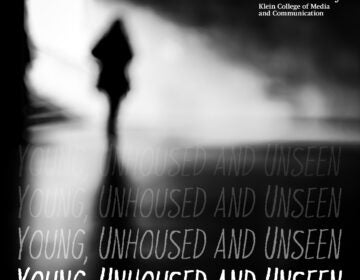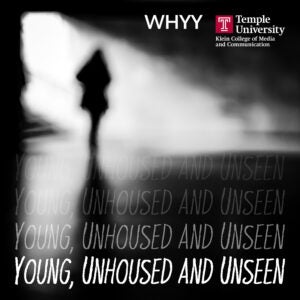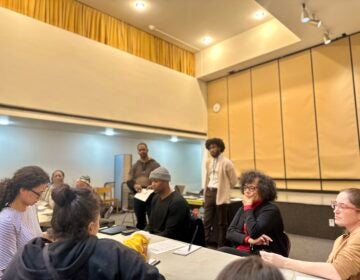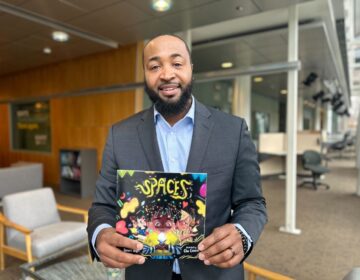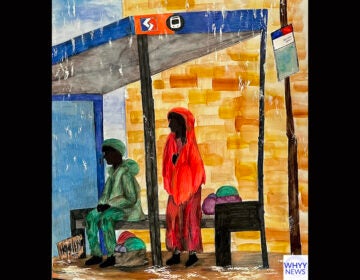Editor’s note: Gen Z is our future and the invisible plight of youth homelessness is examined with active listening in news reporting
WHYY News and Temple Logan Center report on the impacts of youth homelessness on children and young adults up to age 24.
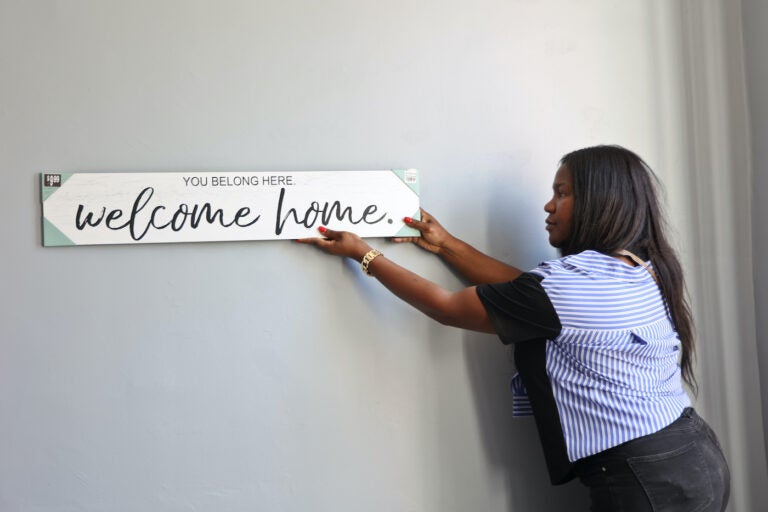
Tatyana Woodward tests space to hang loving art at a new shelter for trans people experiencing homelessness in North Philadelphia. (Kimberly Paynter/WHYY)
WHYY News reports on youth homelessness, the invisible plight for many young people across Greater Philadelphia, with Temple University’s Logan Center for Urban Investigative Reporting, have amplified the importance of active listening and empathy in news reporting. Our explanatory multimedia reporting project, “Young, Unhoused and Unseen,” included a podcast and series of stories, videos and audiograms.
Unsheltered statistics are staggering for Philadelphia youth – one in four unhoused people are aged 24 or younger, according to the city’s 2023 Point in Time Count.
More than 17% of homeless persons are children under the age of 18, and more than 8% of the city’s unsheltered persons are youth ages 18 to 24. Philadelphia’s Point in Time Count is an annual local survey meant to quantify the number of homeless people for the United States Department of Housing and Urban Development (HUD).
As teenagers inch closer to adulthood, our reporting teams found that the root causes of homelessness have a grip on thousands of children and young adults.
The reporting by Logan Center Director Yvonne Latty and WHYY News Reporter Kenny Cooper was marked with empathy. While examining youth homelessness, the team established that there were numerous root causes, such as foster care, poverty, violence, sexual abuse, LGBTQ+ identity, affects of gun violence and mental health.
The reporters’ listening skills garnered new insights and provided honest and untold representation in the series. The scene at the ‘Ark of Safety’ in North Philadelphia in episode four empowered the staff and residents to share their lived truth at the supportive shelter serving LGBTQ+ people.
Another youth shelter in North Philly, Forget Me Knot, is run by the indomitable Mecca Robinson who has poured her heart and soul and personal resources into serving the city’s foster care and youth homeless populations. She says untreated trauma is a real issue as is the lack of funding. Her remarkable work is the focus of episode three of the podcast.
Resident Alexis Pope is a gift and inspiration. In the podcast, the 18-year-old untangles what foster care means to her as a young person who has lived in foster care since she was two-weeks-old and has experienced living in about 20 foster homes. Both of her parents are deceased and she prefers living in a group home, as she called them “way more therapeutic.”
“There is no face to foster care… When people find out my story… how am I supposed to carry myself? Am I supposed to walk around crying all day with my head down? There’s a face to it (foster care)… I wake up smiling and I go to sleep smiling. Everybody got a story,” Pope said.
The “Young, Unhoused and Unseen” reporting journey started with Cooper and Latty examining the origins of an $8 million HUD grant targeted to reverse youth homelessness in Philadelphia in Episode 1 of the podcast. We learned that unsheltered youth contributed to the city’s winning grant proposal.
Yet, the issue isn’t only impacting cities. The challenges facing unsheltered people are seen across Southeastern Pennsylvania, Southern New Jersey and Delaware.
A team of WHYY News reporters documented unhoused stories across the region, including 23-year-old Branden Fletcher, a Gen Zer from Wilmington, Delaware, who is working to address housing insecurity and youth homelessness after experiencing the former.
“The housing system is not built to automatically provide young adults housing. It just doesn’t feel like we’ll ever be able to afford to stay in the communities that we have called home. Homeownership feels very far out of reach for a lot of us,” he said.
Now a candidate for Delaware state representative for the third district, Fletcher is hoping to reverse the trend he sees in his Hilltop neighborhood.
“We need more inclusionary housing, we’re not building enough affordable housing through our zoning. So we have to modify state legislation to require a set of, you know, affordable housing set aside,” Fletcher said.
“Suburban homelessness is almost identical in scale to urban homelessness,” according to Joe Willard, vice president of policy for HopePHL in Philadelphia.
Willard testified to the Pennsylvania Children and Youth and Education Committees last month that absenteeism, transportation and disability are additional challenges for youth experiencing homelessness. In 2022, 40,003 children and youth were identified as homeless across the state of Pennsylvania and of that number 11% of children are unaccompanied, according to Williard.
Stigma and embarrassment likely add to suppressing the number counts, Willard notes, as couch surfing is difficult to quantify and youth homelessness figures may be higher.
Beyond the root causes that emerged from the team’s reporting, there are other signals to note for further reporting following the examination of homelessness data sets, such varying experiences of homelessness by ethnicity and gender.
Black people in Pennsylvania disproportionately experience homelessness. According to HUD Point in Time data from 2022, 72% of the homeless population is Black in Philadelphia and the city’s general population is 40% Black or African American, according to 2022 U.S. Census Bureau data.
Liz Hersh, the former head of Philadelphia’s Office of Homeless Services (OHS), said racism is a cause of homelessness in Philadelphia in episode one of the podcast. Hersh reflects on her eight years working to expand the city’s unsheltered services, which has become nationally recognized. In Thrive by 25, Annie E. Casey Foundation presents recommendations to end the unsheltered youth crisis nationwide, which they report as “one in 10 young adults between the ages of 18 to 25 will experience homelessness over the course of a year.”
Data propels fact-based and explanatory reporting. WHYY News will continue to report on unsheltered youth in 2024 and document the champions who are working to curb the root causes and to create solutions.
With active listening, journalists may build trust with their subjects. The improvement of interviewing skills is another byproduct. A simple pause while interviewing and intentionally making time during the interview process or afterward to understand the subject yields results. These are extra steps beyond just reporting out on what the subject said and will contribute to developing better questions in the future. This approach of active listening should propel journalists to seek more information to report solutions and bring much needed context while practicing complex issues reporting, such as on youth homelessness.

Get daily updates from WHYY News!
WHYY is your source for fact-based, in-depth journalism and information. As a nonprofit organization, we rely on financial support from readers like you. Please give today.



